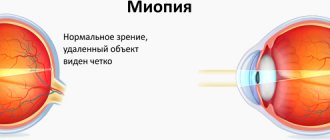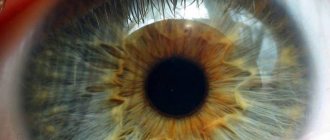General rules for working with a computer
Electronic devices have become such an integral part of human life that it is no longer possible to imagine how people used to cope without them.
With the development of technology in this area, people spend more and more time in front of the monitor, doing work and brightening up their leisure time. Naturally, such a lifestyle cannot but affect eye health. Let's figure out what measures need to be taken to reduce the load on the visual system, how to create optimal working conditions, avoid the occurrence of eye pathologies caused by long periods of time spent at the computer, and consider a series of simple exercises designed to relieve eye fatigue.
Whole methods of proper work have been compiled that help to significantly reduce the load on the body. They contain a set of instructions for arranging the work area, requirements for furniture, peripheral devices, premises, and also give recommendations on how the body is positioned during work. The key points are as follows:
- the room should be well lit, equipped with a ventilation system, or, even better, air conditioning;
- the chair must be equipped with a backrest;
- the working area of the table is at least 50 cm deep;
- input devices (keyboard and mouse) are ergonomically designed;
- It is highly desirable to have a modern video card and monitor.
Prevention of asthenopia
Prevention regarding asthenopia is important. In order to avoid this pathology, you need to follow basic rules:
- working on a computer and reading books in proper lighting, and the humidity in the room should be normal;
- correct regime of eye strain and rest;
- timely qualified diagnosis and treatment of the visual organs;
- modern correction of decreased visual acuity (correct selection of glasses and lenses);
- systematically correct performance of eye gymnastics;
- vitamin therapy for the eyes;
- complete balanced nutrition;
- lead a healthy lifestyle;
- regularly visit an ophthalmologist and follow his recommendations; It is recommended to visit a doctor once a year.
If a person follows all the recommendations of the ophthalmologist and carries out prevention, asthenopia can almost always be cured.
Remember! It is necessary to contact an ophthalmologist in a timely manner.
Key rules for eye care
Every person should take care of their eyes, observe hygiene rules, rest and work schedules, limit time spent on the computer, mobile phone and tablet, lead a healthy lifestyle, follow proper nutrition standards, regularly visit an ophthalmologist and follow his recommendations.
Why does using a computer make your eyes tired and sore?
Unpleasant sensations in the visual apparatus are caused by overwork of the eye muscles. There are several reasons for this:
- physiological characteristics. Human vision is adapted to perceive a three-dimensional image, it contains depth, and the monitor image is two-dimensional, prolonged viewing of which leads to a shift of the focus point beyond the plane of the screen. In an attempt to maintain the usual clarity, the body unconsciously makes great efforts, straining the eye muscle;
- the location of the device relative to the viewer. The eye is designed in such a way that a comfortable field of vision is considered to be vision of objects in front, with a slight downward slope. If the top edge of the monitor is above eye level, then the image “falls out” of the natural range and forces you to actively use the eye muscles;
- glare. Once in the work area, they reduce the contrast of the picture, forcing the visual apparatus to function under heavy loads;
- screen refresh rate. Older monitor models used low image change speeds, about 50-60Hz, which greatly affected eye fatigue. Modern devices do not have this drawback, but discomfort is still felt at the level of peripheral vision;
- Constantly moving your gaze from the sheet of paper to the screen. Increases the load on the extraocular muscles, tiring them.
| Statistical observations have proven the fact that when people look at the monitor they blink less often, the mucous membrane does not receive the required amount of moisture and dries out, creating the feeling of a speck of debris. |
Gymnastics according to Bates
William Bates was the first to develop a system for restoring vision through exercise.
Sit comfortably, straighten your back. When performing gymnastics, it is worth taking off your glasses and lenses, or replacing them with weaker ones. Each exercise is performed 6-8 times and ends with rapid blinks. Move your gaze in the indicated directions:
- Up down.
- Left-Right.
- "Diagonals". Glide your gaze from the upper right corner to the lower left. Blink. Then change the diagonal and move your gaze from the upper left corner to the lower right corner.
- "Rectangle". Smoothly draw a rectangle clockwise with your gaze. Now blink and draw a rectangle in the opposite direction.
- "Clock face". Move your gaze in a circle, first clockwise, then counterclockwise.
- "Snake". From the upper left corner, draw with your gaze a snake leading to the upper right corner. Repeat the movement in the opposite direction.
- "Infinity". Smoothly move your gaze while drawing a figure eight horizontally in the air. Blink your eyes and draw a figure eight backwards.
- "Spiral". Look straight ahead. Start drawing a circle from the center in a spiral, increasing its radius. Blink.
- Now close your eyes and sit for 30 seconds.
Don't forget to blink between exercises. This will help avoid overexertion and improve blood circulation.
Proper organization of a computer workplace
To avoid future vision problems, you need to properly arrange the space where the computer is installed. A few simple recommendations on how to do this:
- The lighting of the monitor and table should be sufficient and uniform; it is advisable to use incandescent lamps with warm emission spectra;
- the screen must be kept clean, not allowing dust and other dirt deposits to accumulate on it;
- set the maximum allowed image refresh rate;
- position the monitor so that its upper plane is slightly below eye level;
- avoid “sunbeams” in the visibility zone, use a screen with anti-glare coating;
- the distance from the viewer should be at least 50-70 cm.
Return to contents
Eyeball massage
It is very useful to end any set of exercises with a massage of the eyeballs. Massage helps relax the eyelids and improve blood circulation. Performed with light, circular movements. For greater effect, you can massage the area around the eyelids, face and head.
A properly selected set of eye exercises will help solve vision problems and prevent their occurrence.
There are many proprietary sets of exercises to improve vision, one of them is eye gymnastics according to Norbekov. We invite you to familiarize yourself with this author’s exercise in the article of the same name.
Rules for working at the computer
Following these simple recommendations, which, unfortunately, are ignored by most, will allow you to maintain your vision at the same level:
- do not spend time watching the monitor in pitch darkness;
- blink more often, give the visual apparatus the opportunity to moisturize and rest;
- maintain uniform lighting of the work area;
- take a 10-15 minute rest every hour;
- During rest, do not neglect to do several exercises for the entire muscle group: raising and lowering your arms, bending to the sides and forward, jumping, squats.
Short exercises should be given special importance; work on a computer is sedentary, does not imply increased physical activity, and as a result leads to serious disorders in the body.
How to do eye exercises to restore vision
Eye exercises to restore vision should be done every day. The eyeballs work thanks to the muscles, so to keep them in good shape it is necessary to perform a set of eye exercises. These exercises not only relieve fatigue and tension, thereby maintaining and improving vision, but also help correct eyelid pathologies.
Exercises for the eyes to improve and restore vision are performed without glasses or contact lenses; women are advised to wash off makeup if possible. To achieve the best results, you should perform the exercises in the morning or evening, before bed.
How to do health-improving exercises for the eyes? It is better to repeat the exercises from five to thirty times, without jerking, smoothly. The recovery technique works best when you start small and gradually increase the number of approaches. It is worth remembering that the result of gymnastics comes if all movements are done without unnecessary tension.
When choosing gymnastics for the eyes, it is worth paying attention to the fact that, in addition to preventive purposes, exercises can also solve existing problems. Typically, the main problems associated with visual impairment are:. • Myopia,
• Myopia,
• Farsightedness,
• Astigmatism.
Next, we will get acquainted in detail with complexes for adults and eye exercises for middle-aged and older children, designed to solve these problems, and also find out whether Khadu for the eyes, Tibetan gymnastics help restore vision, and how massage of the eyeball is useful.
Eye exercises when working on a computer
Physiotherapists have created a large number of complexes designed to relieve tension and fatigue of the visual apparatus. They will be discussed in detail below. Now let’s look at general recommendations that improve blood supply to the eye and strengthen the extraocular muscles:
- to relieve stress and hydrate – blink frequently for a couple of minutes;
- open and close your eyes every 3-5 seconds. to action;
- press lightly on the eyelids;
- move your gaze from distant objects to nearby objects, focusing your gaze for five seconds.
Gymnastics for the eyes when working at a computer is an effective way to prevent visual impairment. Let's look at well-known techniques.
Palming
This exercise was invented by ophthalmologist William Bates. The essence of the training is to relax the eye by doing the following:
- by rubbing your hands together, warm them up;
- Close your eye sockets with your palms, fingers should cross in the forehead area;
- feel the darkness;
- After removing the brushes, feel the temperature difference without looking;
- Close your eyes tightly and slowly open your eyelids.
A simple exercise will restore the brightness of color perception and clarity of vision.
Through my fingers
This training allows you to quickly and effectively relax your visual apparatus and relieve unnecessary tension. It is recommended to do it several times during the day, in moments of rest. The order of execution is as follows:
- place your hands in front of your face, fingers slightly open like a fan;
- make 10-15 turns of your head, without fixing your gaze on anything, but as if looking through an obstacle;
- try not to strain and keep your breathing even.
Writing with your nose
This exercise is universal because, in addition to the eyes, it also relieves fatigue from the neck muscles. After all, tension in it disrupts blood circulation and nutrition of the organs of vision. Follow these steps:
- relax, and with your eyelids closed, imagine that the tip of your nose is a pencil;
- try writing them a letter, a whole word, or drawing a simple picture.
Moving your eyes to the sides
Visual gymnastics is very simple in technique; you need to move your gaze in a horizontal plane, and then from top to bottom. The only thing worth noting is that you need to do it with pleasure, without allowing the muscles of the visual apparatus to strain. Do the workout 15-20 times. To avoid getting dizzy, pause after five repetitions.
Return to contents
Exercise "Big Circle"
The head, when performing this activity, should be motionless. Make orbital movements with your eyes. To simplify, imagine a ball, or say, a watch dial. Lead your gaze along its circumference, first in one direction, then in the opposite direction. Rest for a few seconds, repeat, but this time complicate the execution, stop and fix your gaze on each digit of the clock. When finished, blink slowly.
Endless Eight
As in the previous exercise, the head is motionless, and with your visual apparatus you mentally first draw the largest possible infinity sign, and then the same number of the same name as large as possible, the only rule is, try to do it in such a way as not to experience painful sensations. Repeat each symbol 10-15 times.
Look at the nose
Before performing, you need to relax your eyes, closing them for ten seconds, and then blink them slowly. Then try to see the edge of the nose. The gaze must be fixed for no more than 2 seconds, otherwise you will get the opposite result and strain the extraocular muscles.
Near and far
It is considered the most effective; to perform it, you need to focus your gaze on an object located next to you, and concentrate all your attention on it, and then turn your gaze to a distant object. Repeat the cycle 20 times.
Square
When performing the training, it is enough to keep your head still and draw an imaginary equilateral rectangle with your eyes, trying to outline it as accurately as possible.
Neck massage and exercises
To ensure good blood supply to the brain and eyes in particular, it is necessary to pay attention to the condition of the neck muscles. It is advisable to do a warm-up after taking a bath or shower, or directly during the procedures. Water is a natural sedative and perfectly relaxes.
Self-massage is performed either with your hands or with the help of mechanical or electrical devices, which are considered more effective. Before starting, apply a small amount of cream or oil to the skin, and then, starting with light stroking movements, gradually adding pressure, up to tapping with the edge of the palm, knead the muscles until they are completely warmed up. They combine manipulations with head tilts and circular rotations.
Eye massage
- It is carried out to relieve tension in the visual apparatus, in conjunction with the gymnastic exercises described earlier. The execution method is as follows:
- placing the fingertips on the corners of the eye closest to the bridge of the nose, without lifting them, perform subtle circular movements, first in one direction, and then in the opposite direction;
- repeat the same steps, but with the outer part;
- lightly tap the upper and lower eyelids, and then move on to small pressures.
Eye Gymnastics by William Bates
We became familiar with the methodology for performing this exercise while considering palming. Now let's look at its therapeutic effect. The fact is that the essence of the procedure is immersion in darkness, which needs to be felt, and it, in turn, promotes the production of rhodopsin, a substance important for vision, in the retina. It also provides maximum relaxation of the eye and is considered one of the most effective.
Return to contents
Computer programs for the eyes
The problem of the influence of monitors and other electronic devices on vision motivated software developers to release applications designed to relieve fatigue from the visual system and speed up its recovery.
On the Internet it is not difficult to find a large number of free programs that help maintain a healthy gaze. An illustrative example is one interesting application, Eyes Relax, which displays eye workouts on the monitor screen at user-specified intervals, forcing you to take breaks from work.
| Noteworthy programs include: EyeLoveU, C&V, NI Glaz, NEWBaRest, EyeLeo, Orbis, Workrave. |
The simplest and fastest exercises
It is advisable to print or save the above picture and keep it at hand as a reminder with an elementary simple set of eyeball movements that helps relieve fatigue; believe me, over time you will learn it by heart.
Video exercises
In addition to graphic and schematic images illustrating eye gymnastics, a large amount of material has recently appeared that fully reveals the problem. You just need to type the topic you are interested in in the search bar. As a visual example, we suggest that you familiarize yourself with one of the many video exercises.
Causes of the condition
There are many reasons for the development of tired eyes. Most patients experience severe eye fatigue as a result of prolonged visual strain. The condition is not a disease; it goes away on its own after proper rest. Eye strain is caused by the following factors:
- working on a computer;
- watching TV;
- eyes get tired when using a mobile phone for a long time - social networks, videos;
- reading in poor lighting;
- working with small objects;
- after intense visual work, for example, among truck drivers;
- working with bright light sources;
- constant squinting due to low visual acuity or incorrectly selected correction devices.
At the same time, tension arises in the frontal part of the head, and concentration decreases. The eyes get tired, watery, circles of light appear in front of them.
If a person’s eyes get tired very quickly and their eyes begin to hurt, pathological causes must be excluded. Fatigue is often a sign of some illness:
- migraine is often the first symptom that foretells a pain attack;
- hypertonic disease;
- acute respiratory infections;
- glaucoma, accompanied by increased intraocular pressure;
- dry eye syndrome;
- thyroid diseases;
- vegetative-vascular dystonia;
- osteochondrosis;
- avitaminosis;
- refractive errors - farsightedness or nearsightedness.
Additional stress on the organ of vision is created by surgical interventions and long-term use of medications.
Signs of fatigue
The medical term for eye fatigue is asthenopia. This concept includes not only the state of fatigue, but also the processes that cause it. Asthenopia is a tired eye syndrome, that is, a set of symptoms.
There are many symptoms of eye fatigue:
- foreign body sensation, discomfort;
- headache or eye pain;
- dry mucous membranes or increased lacrimation;
- decreased performance;
- blurred vision;
- redness of the mucous membrane;
- tension in the eyes, manifested by spots, circles, spots of light;
- tired eyes hurt, as if they are bursting from the inside.
To make a diagnosis of asthenopia, it is not necessary to have all the signs of eye fatigue. Two or three symptoms from the list are enough. Asthenopia is said to occur when symptoms are continuously observed for a week or more.
There are also external manifestations of visual fatigue. They are more typical not for diseases, but for a state of general fatigue. There is pallor, dry skin, dark circles on the lower eyelid, and swelling of the eyelids.
What causes vision impairment?
I believe that the main reason for vision deterioration is emotional tension and stress. Hence the recommendation is to use relaxation techniques for both the eyes and the whole body.
Now on the Internet many people advise doing eye exercises. I would like to warn you: if you have a serious visual impairment (more than 3 diopters), then straining your already tense muscles can harm you more than help you. What you need are relaxation exercises. You should start any eye gymnastics with these exercises. And only after a week, add training to the eye muscles, starting with 3 repetitions of each exercise and gradually increasing their number.
The author of relaxation exercises is American ophthalmologist William Bates. He outlined his discoveries in the book “Perfect Vision Without Glasses.” Dr. Bates had several students and followers who improved his technique and wrote their own books. At one time they published a collection “Improving vision without glasses.” It included 2 books - Bates and his student Margaret Corbett. I have a rarity - samizdat 1990
Basic relaxation exercises that are necessary and suitable for absolutely everyone:
- small turns (finger)
- big turns
- solarization (saturation of the eyes with sunlight)
- palming (covering eyes with palms)
Eye exercises are performed without glasses. I recommend that you study them in the original source in order to do them correctly. I will only describe here how to do palming. Since in this exercise the most mistakes are made.
Palming
Warm up your palms by rubbing them together. Straighten the fingers of one hand and cover your eye with your palm. Place the little finger of your other hand across the base of the fingers of your first hand (your arms form something like an inverted V). The intersection of the little fingers should be located where the temple of the glasses is usually located on the bridge of the nose.
Place your elbows on your knees or table. It is very convenient to place a pillow under your elbows. If you must lean forward, bend at the waist while keeping your neck and back straight. Make your palms slightly convex so that they do not put pressure on your eye sockets. The eyes should open and close freely underneath. Adjust the position of your fingers so that there are no gaps between them and light does not pass through them.
Gently close your eyes. Relax your hands, forehead, upper eyelid, lower eyelid, and inner eye muscles.
Now remember something pleasant: a honeymoon, a vacation, beautiful landscapes, joyful events. Remember how you interacted with your loved ones or pets. You can imagine future desired events.
When you remove your hands from your eyes, the world will seem brighter to you. The sensations that you experience during palming need to be remembered so that they become familiar and permanent to you.
Solarization
There is also an important point regarding solarization. This exercise was developed in the first half of the 20th century, when the Earth's ozone layer was not yet damaged. The role of ozone is to block the most dangerous range of ultraviolet radiation from the Sun.
Now the situation has changed dramatically. The ozone layer has become noticeably thinner and no longer serves as a reliable barrier to ultraviolet radiation, which is harmful to the retina and can even cause burns. The visible part of the spectrum, that is, sunlight, is beneficial for the eyes.
What to do? I found a solution: I expose my eyes to the sun only through window glass, which absorbs most of the ultraviolet radiation, but lets in life-giving light. An alternative is to look at the sun at dawn and dusk, when there is little ultraviolet radiation.










